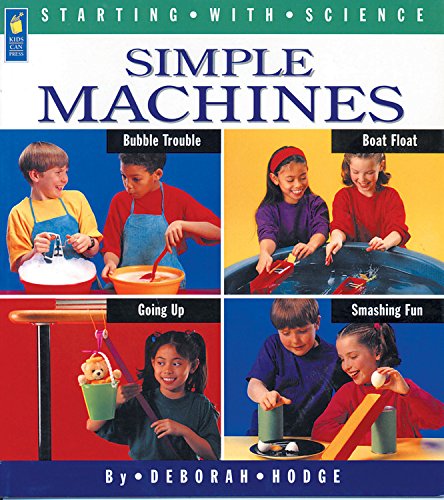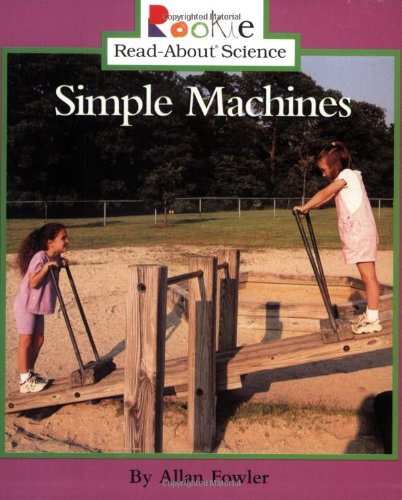-
Simple Machines
D. J. Ward, Mike Lowery
Paperback (HarperCollins, Oct. 6, 2015)Machines help make work easier, like when you need to lift something heavy or reach way up high. There are six simple machines: the lever, the wheel and axle, the pulley, the ramp, the wedge, and the screw. Can you adjust a seesaw to lift an elephant? What happens when you combine two or more simple machines? Read and find out! This nonfiction picture book is an excellent choice to share during homeschooling, in particular for children ages 4 to 6. It’s a fun way to learn to read and as a supplement for activity books for children.With colorful illustrations and engaging text, Simple Machines will delight young readers who love figuring out how things work. Featuring rich vocabulary bolded throughout the text, this book also includes a glossary and a find out more section with a lever experiment and web research prompts. Both the text and the artwork were vetted for accuracy by Dr. Babatunde A. Ogunnaike, dean of the College of Engineering at the University of Delaware.This is a Level 2 Let's-Read-and-Find-Out Science title, which means the book explores more challenging concepts for children in the primary grades and supports the Common Core Learning Standards, Next Generation Science Standards, and the Science, Technology, Engineering, and Math (STEM) standards. Let's-Read-and-Find-Out Science is the winner of the American Association for the Advancement of Science/Subaru Science Books & Films Prize for Outstanding Science Series. O
O
-
Simple Machines
D. J. Ward, Mike Lowery
Hardcover (HarperCollins, Oct. 6, 2015)Machines help make work easier, like when you need to lift something heavy or reach way up high. There are six simple machines: the lever, the wheel and axle, the pulley, the ramp, the wedge, and the screw. Can you adjust a seesaw to lift an elephant? What happens when you combine two or more simple machines? Read and find out! This nonfiction picture book is an excellent choice to share during homeschooling, in particular for children ages 4 to 6. It’s a fun way to learn to read and as a supplement for activity books for children.With colorful illustrations and engaging text, Simple Machines will delight young readers who love figuring out how things work. Featuring rich vocabulary bolded throughout the text, this book also includes a glossary and a find out more section with a lever experiment and web research prompts. Both the text and the artwork were vetted for accuracy by Dr. Babatunde A. Ogunnaike, dean of the College of Engineering at the University of Delaware.This is a Level 2 Let's-Read-and-Find-Out Science title, which means the book explores more challenging concepts for children in the primary grades and supports the Common Core Learning Standards, Next Generation Science Standards, and the Science, Technology, Engineering, and Math (STEM) standards. Let's-Read-and-Find-Out Science is the winner of the American Association for the Advancement of Science/Subaru Science Books & Films Prize for Outstanding Science Series. O
O
-
Simple Machines
Deborah Hodge, Ray Boudreau
Paperback (Kids Can Press, Jan. 1, 1998)Thirteen experiments about the six simple machines -- the lever, wheel and axle, pulley, inclined plane, wedge and screw -- teach kids about basic science. Full-color photographs and step-by-step instructions clearly explain each activity, so that kids can make the most of the machines with minimal help from adults. Part of the Starting with Science series, Simple Machines encourages children to have fun as they learn basic science and fills a need for primary-level science resources. K
K
-
Simple Machines at School
Gillian Gosman
Paperback (Powerkids Pr, Aug. 1, 2014)Introduces simple machines and demonstrates their use at schools. F
F
-
Simple Machines
Allan Fowler
Paperback (Children's Press, Sept. 1, 2001)The natural world comes alive for young readers with Rookie Read-About Science!Rookie Read-About Physical Science series introduces the youngest readers (Ages 6-7) to physical science concepts. Each book features critical-thinking questions throughout the text; a simple, hands-on experiment; a glossary and more. K
K
-
Simple Machines
D. J. Ward, Mike Lowery
eBook (HarperCollins, Oct. 6, 2015)Machines help make work easier, like when you need to lift something heavy or reach way up high. There are six simple machines: the lever, the wheel and axle, the pulley, the ramp, the wedge, and the screw. Can you adjust a seesaw to lift an elephant? What happens when you combine two or more simple machines? Read and find out! This nonfiction picture book is an excellent choice to share during homeschooling, in particular for children ages 4 to 6. It’s a fun way to learn to read and as a supplement for activity books for children.With colorful illustrations and engaging text, Simple Machines will delight young readers who love figuring out how things work. Featuring rich vocabulary bolded throughout the text, this book also includes a glossary and a find out more section with a lever experiment and web research prompts. Both the text and the artwork were vetted for accuracy by Dr. Babatunde A. Ogunnaike, dean of the College of Engineering at the University of Delaware.This is a Level 2 Let's-Read-and-Find-Out Science title, which means the book explores more challenging concepts for children in the primary grades and supports the Common Core Learning Standards, Next Generation Science Standards, and the Science, Technology, Engineering, and Math (STEM) standards. Let's-Read-and-Find-Out Science is the winner of the American Association for the Advancement of Science/Subaru Science Books & Films Prize for Outstanding Science Series.
-
Simple Machines
Tidels
language (, April 22, 2017)Did you know that Archimedes, the Greek Philosopher was the first to recognize the idea of "Simple Machines"?Simple machines are everywhere, and they are the building blocks of complex machines. This book will help lay readers to learn all about the six simple machines (Lever, Pulley, Wheel and Axel, Inclined Plane, Wedge, and Screw) and build working models for better understanding. Read and find out what happens when you combine two or more simple machines.
-
Simple Machines at School
Gillian Gosman
Library Binding (PowerKids Press, Aug. 1, 2014)Scissors are commonly found on school supplies lists, but most students don't recognize them for the simple machines they are. This exploration of school buildings and grounds encourages critical thinking to uncover the simple machines that are often taken for granted and teaches basic physical science concepts in a fun way. O
O
-
Simple Machines
Dana Meachen Rau
Paperback (Childrens Pr, Sept. 1, 2011)A True Book-Physical Science Whether you're an aspiring inventor or an everyday science buff, you've probably created your own experiments to uncover the truth about the forces of physical science. Now you can delve deeper into the topics of electricity, motion, gravity, and more with these titles that are perfect for the budding scientist in you. U
U
-
Simple Machines
Cody Crane
Paperback (Children's Press, Feb. 1, 2019)From levers to pulleys, simple machines make our lives easier.Rookie Read-About Physical Science series introduces the youngest readers to physical science concepts. Each book features critical-thinking questions throughout the text; a simple, hands-on experiment; a glossary and more. This series is aligned to the Next Generation Science Standards. They help roll, lift, cut, tip, and turn everyday objects. In Simple Machines readers will dig into the science behind how we use simple machines to get the job done. K
K
-
Simple Machines
Deborah Hodge, Ray Boudreau
Hardcover (Kids Can Press, June 30, 1996)Thirteen experiments about the six simple machines -- the lever, wheel and axle, pulley, inclined plane, wedge and screw -- teach kids about basic science. Full-color photographs and step-by-step instructions clearly explain each activity, so that kids can make the most of the machines with minimal help from adults. Part of the Starting with Science series, Simple Machines encourages children to have fun as they learn basic science and fills a need for primary-level science resources. O
O
-
Simple Machines
Eve Heidi Bine-Stock, Katerina Davidenko
Paperback (Independently published, April 7, 2020)This fun book explores the six simple machines: inclined plane, wedge, screw, lever, wheel & axle, and pulley.A poem introduces the problem: How can we make work easier?Kid-friendly text and pictures then explain and show how each machine works and helps us. Examples are given from everyday life that children are familiar with, along with illustrations of kids using the machines.Children are gently introduced to the vocabulary of physics and engineering, along with guides to pronunciation.This is the best book available to teach your little ones these important concepts!Buy now and enjoy!